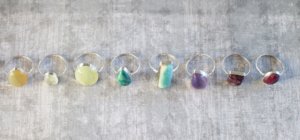[vc_row][vc_column][vc_column_text] You have discovered the colorful world of gems; now it is time to decide on the perfect gemstone for you! Which gemstone will suit you best? How much do gemstones cost? Which gemstones are the most durable? What types of gemstone jewelry are in fashion right now? How long will your gemstone last? Is there a gemstone that is perfect for you? Read on for some surprising gemstone facts and expert answers to aid your search and give you the knowledge and confidence to choose the perfect gemstone for you. Note – the below post discusses the selection of gemstones from a jewelry perspective – check out this article to learn about selecting stones from a healing perspective.
You have discovered the colorful world of gems; now it is time to decide on the perfect gemstone for you! Which gemstone will suit you best? How much do gemstones cost? Which gemstones are the most durable? What types of gemstone jewelry are in fashion right now? How long will your gemstone last? Is there a gemstone that is perfect for you? Read on for some surprising gemstone facts and expert answers to aid your search and give you the knowledge and confidence to choose the perfect gemstone for you. Note – the below post discusses the selection of gemstones from a jewelry perspective – check out this article to learn about selecting stones from a healing perspective.
Your Perfect Gemstone
Gemstones are typically described in two major ways: “precious” and “semi-precious.” The precious gems are diamonds, rubies, sapphires, and emeralds. The semi-precious gems are, well, everything else. This can be confusing, since there is a mighty span in the pricing of semi-precious gems. Some are very rare and command top dollar. Others, however beautiful, are common and easily affordable. Subject to your budget (which we will discuss next), the first step is to pick the color(s) you love – because colors are the prime ‘C’ in the world of gemstones.
How to DeterminE Your Gemstone Budget?
While figuring out how much you can expect to spend on a gemstone or on gemstone jewelry, it helps to answer the following questions first:
- Are you interested in precious or semi-precious gems?
- Will you expect to wear your gemstone jewelry every day?
- Are you seeking a “statement piece” of gemstone jewelry?
- Will you plan to build your jewelry wardrobe to include a certain gemstone color scheme?
If you plan on spending under $100, you can expect to find attractive semi-precious gems such as amethyst, citrine, peridot, turquoise, and treated topaz in this price range. The gems will not be particularly large at this price point, but colorful and attractive demure accessories. Amethyst is commonly subjected to heat treatments to enhance its color, and turquoise is frequently dyed. This information should be disclosed by the seller. Don’t forget to ask! A simple question, “Has this gemstone been heat treated or dyed?” posed before the time of purchase will tell you volumes about the gem seller. An indirect, uninformed, or evasive answer should be enough to make you reconsider your choice of vendor.
If you are interested in acquiring precious gems but your budget is an issue, you can still afford precious gemstone jewelry. Be prepared to accept precious gems such as rubies and sapphires in smaller sizes. Tiny gems that accent precious metal jewelry can be found for well under $500.00. If someone is offering to sell you a large precious gemstone (one carat or above) for less than $500.00, be wary. The gemstone may not be genuine.
Semi-precious gemstones that can be obtained for $500 or less include tourmaline, opal, aquamarine, morganite, prasiolite, and garnet in smaller sizes as well as the less rare semi-precious gems such as amethyst, citrine, peridot, and iolite in larger sizes.
For fine quality precious gems, expect to pay $2,000.00 or more. It is easy to justify the expense of fine jewelry, especially if you plan to wear it frequently. Just make sure that the gemstone you choose is durable enough for daily wear.
Which Gemstone is Right for You?
Depending on how you plan to wear your gemstone, there are a number of ways to determine which gems are right for you. A gemstone pendant will not be subjected to much “wear and tear”; meaning the gemstone is not going to come into contact with hard surfaces or other gemstones. The same is true for gemstone earrings. A ring or bracelet, however, will come into contact with a variety of surfaces, some of which can damage a gemstone. In selecting gems to be worn on the hand or wrist, chose a gem with a Mohs hardness rating of seven or higher.
The Mohs Scale of Hardness was developed by German scientist Friedrich Mohs in 1812 to categorize minerals. In science, hardness is defined as a resistance to scratching. The harder a mineral is, the better it will hold up under daily wear, especially if it is to be worn in a ring or bracelet. Semi-precious gemstones rated seven or higher on the Mohs scale include all varieties of quartz such as amethyst, citrine, rose quartz, and prasiolite as well as topaz. Precious gems rated seven or higher include rubies, sapphires, and diamonds.
Gemstone Fashion
Gemstones have been a part of our culture for centuries. Once reserved for nobility and royalty, the status and pleasure derived from owning gemstones is now accessible to many. Current fashions include large semi-precious gems framed with very small diamonds, called melee. Variations on this trend include the use of very small precious gems as frames, “halos,” or accents to larger gemstones. Whether you are drawn to modern designs or antiques, frequently referred to as “estate jewelry”, gemstones when cared for properly will delight for generations. Consider your wardrobe, your lifestyle, your personal taste, and your budget. All these factors are important when deciding which gemstone is right for you. Let us know which is your favorite gemstone, and we will feature it on GemstoneGuru.
Read more posts from the Gemstone Buying Guide series.[/vc_column_text][/vc_column][/vc_row]
